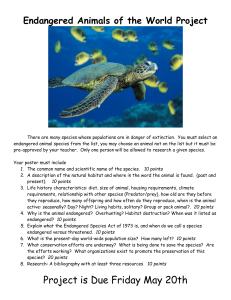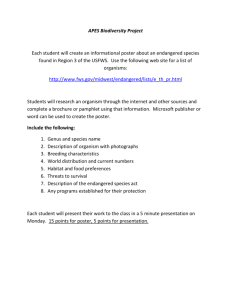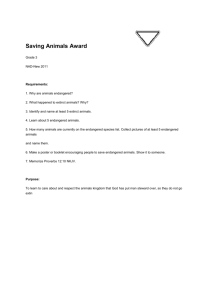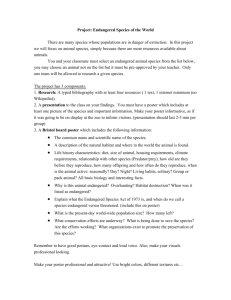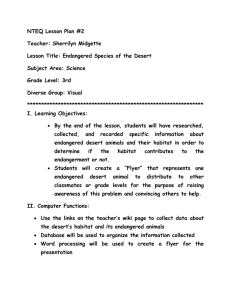Endangered Animals of the World Project
advertisement
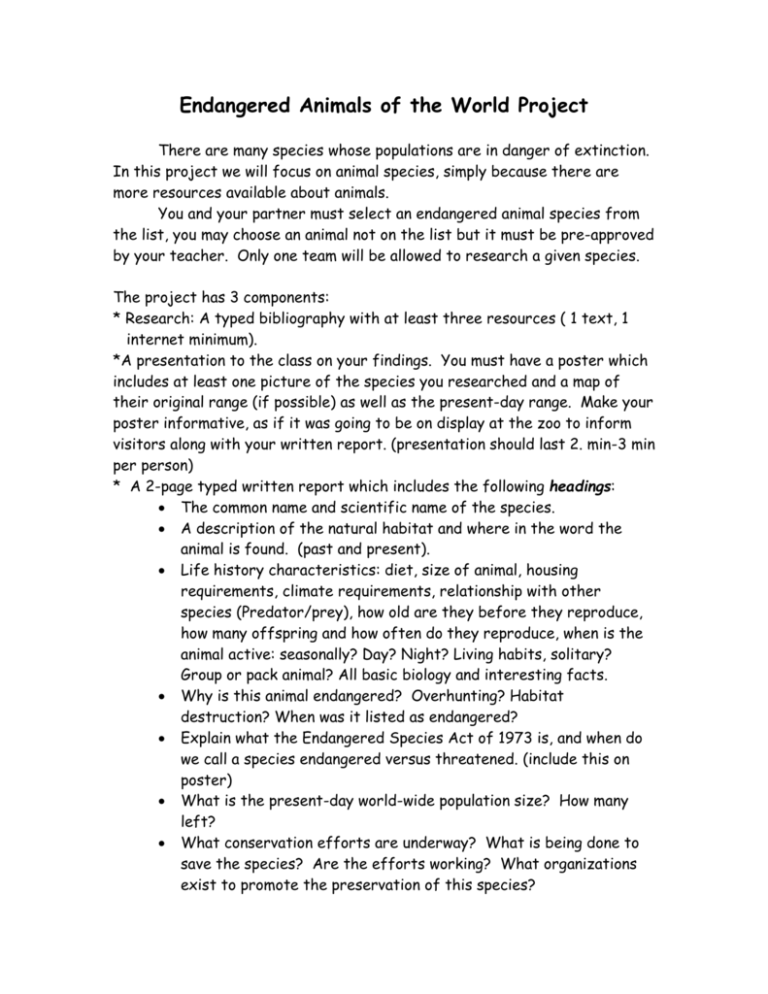
Endangered Animals of the World Project There are many species whose populations are in danger of extinction. In this project we will focus on animal species, simply because there are more resources available about animals. You and your partner must select an endangered animal species from the list, you may choose an animal not on the list but it must be pre-approved by your teacher. Only one team will be allowed to research a given species. The project has 3 components: * Research: A typed bibliography with at least three resources ( 1 text, 1 internet minimum). *A presentation to the class on your findings. You must have a poster which includes at least one picture of the species you researched and a map of their original range (if possible) as well as the present-day range. Make your poster informative, as if it was going to be on display at the zoo to inform visitors along with your written report. (presentation should last 2. min-3 min per person) * A 2-page typed written report which includes the following headings: The common name and scientific name of the species. A description of the natural habitat and where in the word the animal is found. (past and present). Life history characteristics: diet, size of animal, housing requirements, climate requirements, relationship with other species (Predator/prey), how old are they before they reproduce, how many offspring and how often do they reproduce, when is the animal active: seasonally? Day? Night? Living habits, solitary? Group or pack animal? All basic biology and interesting facts. Why is this animal endangered? Overhunting? Habitat destruction? When was it listed as endangered? Explain what the Endangered Species Act of 1973 is, and when do we call a species endangered versus threatened. (include this on poster) What is the present-day world-wide population size? How many left? What conservation efforts are underway? What is being done to save the species? Are the efforts working? What organizations exist to promote the preservation of this species? Remember to have good posture, eye-contact and loud voice. Also, make your visuals professional looking, always proofread your reports and have the correct format for your bibliography. Species List Remember you can always research a species not listed here— but check with your teachers first. You must sign up with your teacher. Mammals 1. Black-footed ferret 2. Black-tailed prairie dog 3. bowhead whale 4. Florida panther 5. Gray bat 6. Manatees 7. Gray wolf 8. Brown/Grizzly Bear 9. Bobcat 10. Stephen’s kangaroo rat 11. Cheetah 12. Blue whale 13. African elephant 14. Mountain Gorilla 15. Pygmy hippopotamus 16. Black rhinoceros 17. Grevy’s zebra 18. Chinese river dolphin 19. Asian elephant 20. Snow leopard 21. Asiatic Lion 22. Giant panda 23. Tiger 24. Giant ant eater 25. Jaguar Invertebrates 1. Queen Alexandra’s birdwing butterfly 2. vernal pool fairy shrimp Birds 1. California condor 2. Whooping crane 3. Bald eagle 4. California clapper 5. Ivory-billed woodpecker 6. Hawaiian hawk 7. Crested honeycreeper 8. Peregrine falcon 9. Northern Spotted owl Fish 1. Desert pupfish 2. Chinook salmon 3. Slender seahorse 4. Coelacanth Amphibians 1. Goliath frog 2. Desert slender salamander 3. Chinese giant salamander Reptiles 1. American alligator 2. American crocodile 3. Gila monster 4. Desert tortoise 5. Galapagos land iguana 6. Leatherback sea turtle 7. Komodo Island monitor 8. Gavial 9. Galapagos tortoise 10. Indian python
